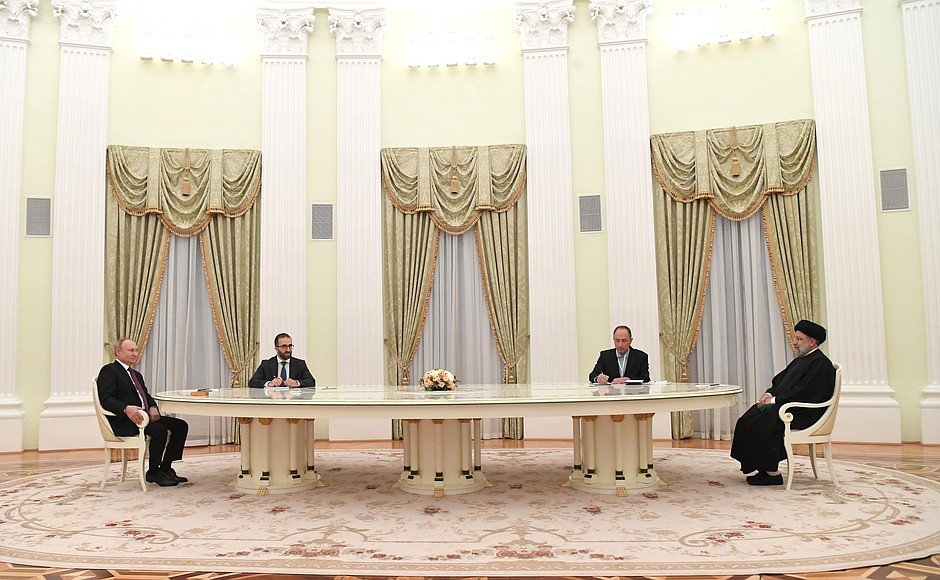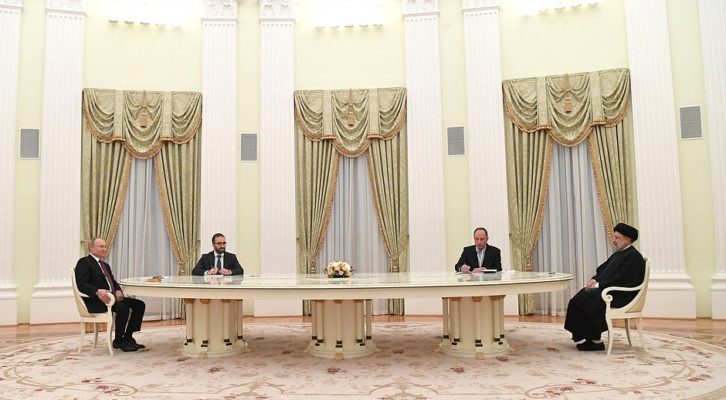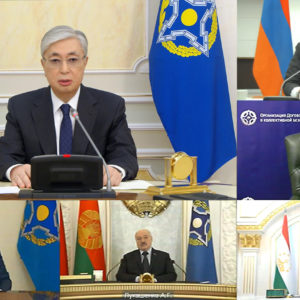
Russian President Vladimir Putin meets with President of Iran Sayyid Ebrahim Raisi in Moscow, January 19, 2022
On January 19, 2022, Iranian President Dr. Ibrahim Raisi traveled to Moscow and met his Russian counterpart Vladimir Putin in an effort to improve bilateral ties between both countries. The leaders discussed regional and international issues, among them the negotiations around Iran’s nuclear program and regional cooperation in Eurasia. However, contrary to expectations and some statements before the meeting, the visit, for now, has failed to achieve a major advance in addressing the Iranian expectations, mostly related to the signing of a strategic agreement like the one between China and Iran a year ago. Nevertheless, the visit pushed the negotiations between both sides to a higher level and facilitated Iran’s economic integration in Russian-Chinese Eurasian architecture.
What was expected from the meeting?
Amid the construction of a new security architecture in Eurasia, China, Russia and Iran are coming closer to creating a strong deterrent force against US ambitions in the region. It is within these geopolitical dynamics that we should assess Iran’s recent diplomatic success in joining the Shanghai Cooperation Organization (SCO). This was seen as a major step to facilitate Iran’s integration in Eurasia. Iran’s Foreign Minister spokesperson Saeed Khatibzadeh tweeted that this was a “major step toward enhanced ties with neighbors and an important impetus for (Iran’s) Asia-centered foreign policy.” Hence, as the US continues imposing sanctions on Iran, Tehran is further moving and integrating with its Eastern partners. The Iranians view these developments as part of a rising “eastern coalition” emerging with China and Russia.
This is why Iran actively participated in China’s “Belt and Road Initiative.” Then in March 2021, the foreign ministers of Iran and China—Javad Zarif and Wang Yi respectively—signed an agreement on a comprehensive strategic partnership for a period of 25 years. The agreement provides for the development of relations between the two countries in 20 different areas including politics; the cooperation of executive authorities; cultural, legal and defense spheres; security; and regional and international problems.
According to the agreement, China is to invest 400 billion USD in Iran’s economy over that time period in exchange for a steady and heavily discounted supply of oil from Iran. Iranian authorities claimed that, as part of reviving the Chinese One Belt One Road Initiative, the agreement includes up to 280 billion USD towards developing Iran’s oil, gas and petrochemical sectors and another investment of 120 billion USD towards upgrading Iran’s transportation and manufacturing infrastructure.
To further facilitate the integration process and consolidate its position in Eurasia, Iran sought to sign a similar agreement with Russia. In recent years, improving relations between Tehran and Moscow and “focusing on the strategic partnership” have become particularly important tasks for Iran. In October 2021, the Interfax quoted Iranian Foreign Ministry spokesman Said Khatibzadeh, who said that Tehran is ready to sign a strategic partnership agreement with Moscow and expects both parties to sign the documents in the coming months. According to the TASS agency, both sides are close to completing work on a document on comprehensive cooperation for a period of 20 years.
The Iranian Foreign Ministry also added that the “Global Cooperation Agreement” between Iran and Russia was completed in the first stage of the preparation of this document. Now both sides are finalizing some provisions of the treaty, which will then be sent to Moscow. During a November 16 phone conversation, President Raisi told President Putin that Iran was ready to conclude a long-term agreement on comprehensive cooperation with Russia. The “Treaty on the Basics of Relations and Principles of Cooperation between Russia and Iran” was signed in March 2001, and its validity period was automatically renewed every five years. On September 24, 2020, during a visit to Moscow, the then-Iranian Foreign Minister Mohammad Javad Zarif said that before the next extension, the Iranian side intends to consider the possibility of updating the document taking into account the current realities.
The timing is important for both countries. Mojtaba Zulnur, chairman of the National Security and Foreign Policy Commission of Iran’s Parliament, told the Mehr agency that in order to overcome US sanctions, Iran seeks a partnership agreement with Russia, which would be analogous to the agreement concluded between Tehran and Beijing. Hence, the content and the timing of the agreement should be viewed from this perspective. The more the West imposes sanctions on Iran, the more Tehran will move towards the East and be part of the new security structure in Eurasia.
However, contrary to expectations and some statements prior to the Iranian leader’s trip to Russia, President Raisi’s visit failed, at least for the time being, to achieve a major breakthrough. The two sides have been working to boost trade and economic ties in particular, although an additional impetus may be given to the development of the military-political dimension of interaction in the future. But so far it seems that the parties have not been able to agree on the terms of the strategic agreement. This process may take some time and can be linked to the outcome of the Iranian nuclear negotiations. Yet the greater resonance of Raisi’s visit to Moscow is the planned joint naval exercises between Russia, China and Iran in the Indian Ocean, as well as Iran’s relations with the Eurasian Economic Union (EAEU) alongside the materialization of the International North-South Transport Corridor.
Is Iran joining the Eurasian Economic Union anytime soon?
Iranian political analyst Seyed Mostafa Khoshcheshm argues that Russia may push for Iran’s accession to the EAEU. He told the Weekly that “negotiations are already underway.” In 2019, the Preferential Trade Agreement (PDA), which was signed between Iran and the EAEU in 2018, entered into force. The agreement offered lower tariffs on 862 commodity types, of which 502 are Iranian exports to the EAEU. As a result, from October 2019 to October 2020, the trade volume increased by more than 84 percent. According to Vali Kaleji, an Iranian expert on Central Asia and Caucasian Studies, this volume of trade was achieved at a time when the United States under former President Donald Trump withdrew from the Joint Comprehensive Plan of Action (JCPOA) in May 2018 and was following the policy of “maximum pressure” against Iran. Since October 2021, Iran and EAEU have been negotiating on upgrading the PDA into a Free Trade Agreement (FTA). If agreed, this will set off a massive increase in the volume of trade between Iran and the Union.
Both Moscow and Tehran have their reasons to push for further integration of Iran in the Union. For Iran, this opportunity will provide better access to Eurasian and European markets. It will also provide EAEU member states with increased access to the Persian Gulf and even the Mediterranean Sea. For this reason, Moscow may think a step ahead. Moscow views the signing of the FTA agreement with Iran as a crucial step for Iran’s accession to the Union. Russia has concerns that if Iran reaches an agreement with the US over its nuclear issue, there may be certain positive Iranian policy shifts towards the West, and this may not serve Russia’s interests in the Middle East, especially in Syria. For Russia, a nuclear Iran is more preferable than a pro-Western one. For this reason, Russia would be glad to see Iran’s integration into Eurasian regional institutions being accelerated. Iran’s accession to the Shanghai Cooperation Organization should be viewed from this perspective. Moreover, with Tehran joining the EAEU, neighboring and friendly countries such as Iraq and Syria may follow. Hence, Russia would have a direct railway and highway connection via Iran to its Syrian coastal military base in Tartus. This would serve its military goals on a logistic and operational level in case a crisis breaks out in the Black Sea and Russia’s navy faces certain challenges.
On December 27, 2021, Iran and Iraq agreed to build a 30-kilometer railway connecting both countries. This would be of strategic importance for Iran, linking the country to the Mediterranean Sea via Iraq and Syria’s railways. It would also be favorable for both China and Russia; Beijing through the “Belt and Road Initiative” and Russia through the “International North-South Transport Corridor” would have direct railway access to the Mediterranean Sea. This route would also compete with India’s “Arab-Mediterranean Corridor” connecting India to the Israeli port of Haifa through the UAE, Saudi Arabian and Jordanian railways. Hence for China and Russia, Iran’s geopolitical and geo-economic position will be consolidated in the region. From a Russian perspective, having a direct land route through the Levant to the Mediterranean will further consolidate its power base in Syria and extend its soft power through trade and energy deals around the neighboring countries.
It was for this reason that Iran acted prudently against the recent Azerbaijani provocations on the Armenian border. Tehran’s concern was that Turkey would have direct access to the Caspian and Central Asia through a possible “corridor” passing from southern Armenia. This is known as the “Trans-Caspian International Transport Route Middle Corridor.” connecting Europe to Central Asia through Turkey. For Iran, such a move was equivalent to NATO’s expansion to the Caspian Sea and further towards China. Hence the “West-East” trade route would pose a serious threat to Iran and Russia and isolate them in Eurasia. For the Iranians, this route would not only bypass Iran and Russia but also jeopardize and impose a serious challenge to the “North-South” trade route that is initiated by the Iranians, Russians and other Asian countries. According to Khoshcheshm, “these animosities by the Western block have driven Iran and Eurasia closer to each other, and this has given strong motivation for the Russians and Chinese to speed up Iran’s accession to the Eurasian block to hammer joint cooperation in economic and geopolitical areas and prevent US penetration into the region.”
Iran’s membership in the EAEU is a win-win situation for both Moscow and Tehran. Russia would have consolidated its geo-economic and geopolitical position in the Middle East, and Iran would have a railway connection to Russia and Europe thus further expanding Moscow’s influence in the region. However, the realization of this objective still may need time and will face challenges from the US and its allies in the region.
Impact on the South Caucasus and the Middle East
Iran’s possible accession to the EAEU would attract investments from neighboring countries to the underdeveloped rail communication between Iran and Russia in the Caucasus region. The opening of the communication channels between Armenia and Azerbaijan, as part of the November 9 trilateral statement, would facilitate trade and cargo transportation in the region as part of the North-South corridor. In such circumstances, the railway network is important since the volume of goods transported by rail is far greater and faster than the land and truck routes. This would be beneficial for Armenia, which would have a railway connection not just toward the Persian Gulf but also to the Eastern Mediterranean in the future. Such an initiative would create economic interdependence between the South Caucasus and the Middle East.
However, the implementation of these projects is not certain. Russian Railways, a state-owned entity, ceased implementation of its projects in Iran in April 2020 in fear of US sanctions. Such a decision harms the implementation of other programs within the framework of the Russian-Iranian initiative to create the North-South Transport Corridor. Both sides have to find a way to overcome US sanctions, as economic routes would be ideal. By joining the EAEU and integrating into Eurasian regional organizations, Iran would consolidate its geo-economic position into a regional transport hub and open the Middle Eastern gate for Moscow to have railway access to the East Mediterranean.
The article was originally published in the Armenian Weekly, 2/2/2022.
Yeghia Tashjian is a regional analyst and researcher. He has graduated from the American University of Beirut in Public Policy and International Affairs. He pursued his BA at Haigazian University in political science in 2013. In 2010, he founded the New Eastern Politics forum/blog. He was a research assistant at the Armenian Diaspora Research Center at Haigazian University. Currently, he is the regional officer of Women in War, a gender-based think tank. He has participated in international conferences in Frankfurt, Vienna, Uppsala, New Delhi and Yerevan. He has presented various topics from minority rights to regional security issues. His thesis topic was on China’s geopolitical and energy security interests in Iran and the Persian Gulf. He is a contributor to various local and regional newspapers, a columnist in the Armenian Weekly and a presenter of the “Turkey Today” program for Radio Voice of Van. Recently he has been appointed as associate fellow at the Issam Fares Institute for Public Policy and International Affairs at the American University of Beirut and Middle East-South Caucasus expert in the European Geopolitical Forum.







